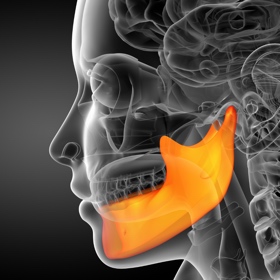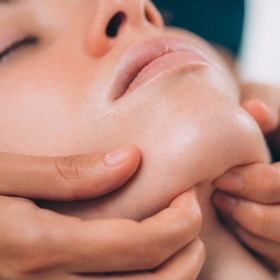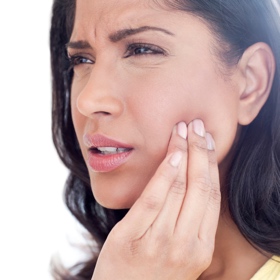TMD Treatment
Temporomandibular joint disorder TMD, also known as TMJ, is estimated to affect 1 in 4 people according to the British Dental Health Foundation.
It is often a debilitating condition that can cause intense pain, often described as a dull aching pain in the jaw joint and nearby areas, such as the temporalis muscles of the head, the neck, scalp and shoulders and affect the quality of a person’s life.
There are three main classes of TMDs:
- Disorders of the joints, including disc disorders.
- Disorders of the muscles used for chewing (masticatory muscles).
- Headaches associated with a TMD
 The TMJ is a hinge joint that connects the mandible (lower jaw) to the temporal bone of the skull. It is composed of bones, ligaments, cartilage, synovial fluid, blood vessels, nerves and a shock-absorbing articular disc. They are the most important and most used joints in the body and enable movement when talking, singing, chewing, eating, and yawning.
The TMJ is a hinge joint that connects the mandible (lower jaw) to the temporal bone of the skull. It is composed of bones, ligaments, cartilage, synovial fluid, blood vessels, nerves and a shock-absorbing articular disc. They are the most important and most used joints in the body and enable movement when talking, singing, chewing, eating, and yawning.
Pain from TMD can occur if the disc is not sitting in the normal position within the joint, if the joints are damaged by arthritis or trauma or due to bruxism, a term given to severe grinding of the teeth caused by emotional stress, side effects of certain medications and/or a genetic predisposition. Bruxism can lead to headaches, migraines, disturbed sleep, muscle pain and damage to the teeth.
The most common symptoms of TMD include localised jaw and facial pain, ear pain, jaw clicking, misalignment, and limited mouth opening.
 The good news is that even if there is a physical problem with the disc or the joint itself, the surrounding musculature will often be involved and therefore the pain can be significantly reduced and the function improved with massage, intra-oral work, trigger point therapy and acupuncture.
The good news is that even if there is a physical problem with the disc or the joint itself, the surrounding musculature will often be involved and therefore the pain can be significantly reduced and the function improved with massage, intra-oral work, trigger point therapy and acupuncture.
Hayley D'Arcy and Becky Clarke are offering TMD treatment at Shine, involving massage and intra-oral work for the specific treatment of TMD pain and discomfort.
Hayley offers an initial appointment (60 minutes) begins with a palpating and visual assessment of  the jaw and face followed by shoulder work to the trapezius and surrounding muscles, then up towards the neck and often tight sternocleidomastoid muscle (SCM) using trigger points.
the jaw and face followed by shoulder work to the trapezius and surrounding muscles, then up towards the neck and often tight sternocleidomastoid muscle (SCM) using trigger points.
Once lying on your back the intra-oral work can begin using non-latex gloves inside the mouth and around the gums and masseter muscle (one of the main muscles of mastication). Intra-oral work can feel tender initially, especially around overused muscles that have tightened up over time from habitual clenching, and it usually mirrors the sensitivity of the intricate neck muscles, but can leave you feeling lighter, looser and remarkably mobile even after the first session. However, not everyone responds the same so depending on whether the issue is acute or chronic a course of 4-6 treatments is recommended.
The techniques and modalities involved complement each other remarkably well, and whether you experience massage, trigger point therapy, acupuncture (with Hayley only) and/or hot stones during your treatment, the protocol has been created to offer relief to the many TMD sufferers, making a real difference to the way we hold and move our jaw day to day.
 Becky begins with an email consultation form and talk before treatment. Provided you answer the form, a 60min initial treatment is fine, otherwise she would suggest a 75mins appointment.
Becky begins with an email consultation form and talk before treatment. Provided you answer the form, a 60min initial treatment is fine, otherwise she would suggest a 75mins appointment.
As a Massage Practitioner with extensive experience in working with injury, the structure and function of the body, and myofascial release, she works over a broader area of the body to connect what else can contribute to TMD.
“The pelvis and jaw are like mirrors to each other and are connected through the deep front line of the body’s fascial system. If you can release the hips, it often has an impact on the jaw.” Becky.
Becky’s approach works the upper back, neck, and jaw, but also the glutes, piriformis and some grounding work into the feet. Becky works the masseter from the outside first and then goes intra- orally.
Both Hayley and Becky may use Hot Stones as part of their treatment depending upon your presenting needs. Read their profiles to find out more and to get in touch.
